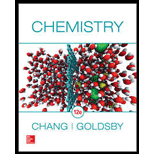
Define equilibrium. Give two examples of a dynamic equilibrium.
Interpretation:
The definition for equilibrium and two examples for dynamic equilibrium should be explained.
Concept Introduction:
Chemical equilibrium: The term applied to reversible chemical reactions. It is the point at which the rate of the forward reaction is equal to the rate of the reverse reaction. The equilibrium is achieved when the concentrations of reactants and products become constant.
Forward Reaction: This type of reaction has involved irreversible, if obtained product cannot be converted back in to respective reactants under the same conditions. Backward Reaction: This type of reaction process involved a reversible, if the products can be converted into a back to reactants.
Equilibrium expression: The equilibrium expression is equal to the concentration of each product raised to its coefficient in a balanced chemical equation and multiplied together, divides by the concentrate ions of the product of reactants to the power of their coefficient.
Homogeneous equilibrium: A homogeneous equilibrium involved has a everything present in the same phase and same conditions, for example reactions where everything is a gas, or everything is present in the same solution.
Heterogeneous equilibrium: This equilibrium reaction does not depend on the amounts of pure solid and liquid present, in other words heterogeneous equilibrium, substances are in different phases.
Dynamic equilibrium: Both the forward and the backward reaction tends to occur without any net change in the concentrations of both reactant and the product.
Answer to Problem 14.1QP
The chemical equilibrium is the point at which the rate of the forward reaction is equal to the rate of the reverse reaction. The equilibrium is achieved when the concentrations of reactants and products become constant.
Examples for dynamic equilibrium are as follows,
Explanation of Solution
The term applied to reversible chemical reactions. It is the point at which the rate of the forward reaction is equal to the rate of the reverse reaction. The equilibrium is achieved when the concentrations of reactants and products become constant.
The equilibrium is a dynamic state where both the forward and the backward occur simultaneously without any change in the concentrations of the reactant and the product.
The examples for the dynamic equilibrium are as follows,
The reaction
Similarly the reaction between carbon monoxide and chlorine also serves as example for dynamic equilibrium
The definition for chemical equilibrium and the examples for dynamic equilibrium are determined.
Want to see more full solutions like this?
Chapter 14 Solutions
Chemistry
- i need help on how to complete the followingarrow_forwardno AI walkthrough current image is wrong answerarrow_forwarda. Determine whether each of the Followery Molecules is in the R- On the y- Configuration 1-01"/ 1-6-4 Br 4 I el Br b. Draw The Fisher projection For all the Meso compounds that can exist FOR The Following molenlearrow_forward
- 1- Refer to the monosaccharides below to answer each of the following question(s): CH₂OH CHO CH₂OH CH₂OH 0 H- OH 0 0 HO- H H- -OH HO H HO H H OH HO- H CH₂OH H. OH HO H HO- H CH₂OH CH₂OH CH3 a. Sorbose b. Rhamnose c. Erythrulose d. Xylulose Classify each sugar by type; for example, glucose is an aldohexose. a. Xylulose is .. b. Erythrulose is . c. Sorbose is .. d. Rhamnose is .. 2- Consider the reaction below to answer the following question(s). CHO H OH CH₂OH CH₂OH HO- H HO HO + H. -OH HO OH HO. H OH OH H -OH H OH CH₂OH Q Z a. Refer to Exhibit 25-11. Place a triangle around the anomeric carbon in compound Q. Compound Z is: b. 1. the D-anomer. 2. the a-anomer. 3. the ẞ-anomer. 4. the L-anomer. c. Which anomer is the LEAST stable? d. Q and Z are cyclic examples of: a. acetals b. hemiacetals c. alditols d. hemialditolsarrow_forwardi need help identifying the four carbon oxygen bonds in the following:arrow_forwardImagine each of the molecules shown below was found in an aqueous solution. Can you tell whether the solution is acidic, basic, or neutral? molecule HO H3N + The solution is... X O acidic OH O basic H3N-CH-C-O O neutral ○ (unknown) O acidic ○ basic CH2 CH 3-S-CH2 O neutral ○ (unknown) H3N O OH O acidic O basic Oneutral O (unknown) 0 H3N-CH-C-O CH3 CH CH3 O acidic O basic O neutral ○ (unknown) ? olo Ar BHarrow_forward
- Chemistry: Matter and ChangeChemistryISBN:9780078746376Author:Dinah Zike, Laurel Dingrando, Nicholas Hainen, Cheryl WistromPublisher:Glencoe/McGraw-Hill School Pub Co
 Living By Chemistry: First Edition TextbookChemistryISBN:9781559539418Author:Angelica StacyPublisher:MAC HIGHER
Living By Chemistry: First Edition TextbookChemistryISBN:9781559539418Author:Angelica StacyPublisher:MAC HIGHER Chemistry: The Molecular ScienceChemistryISBN:9781285199047Author:John W. Moore, Conrad L. StanitskiPublisher:Cengage Learning
Chemistry: The Molecular ScienceChemistryISBN:9781285199047Author:John W. Moore, Conrad L. StanitskiPublisher:Cengage Learning  ChemistryChemistryISBN:9781305957404Author:Steven S. Zumdahl, Susan A. Zumdahl, Donald J. DeCostePublisher:Cengage Learning
ChemistryChemistryISBN:9781305957404Author:Steven S. Zumdahl, Susan A. Zumdahl, Donald J. DeCostePublisher:Cengage Learning World of Chemistry, 3rd editionChemistryISBN:9781133109655Author:Steven S. Zumdahl, Susan L. Zumdahl, Donald J. DeCostePublisher:Brooks / Cole / Cengage Learning
World of Chemistry, 3rd editionChemistryISBN:9781133109655Author:Steven S. Zumdahl, Susan L. Zumdahl, Donald J. DeCostePublisher:Brooks / Cole / Cengage Learning Chemistry: Principles and PracticeChemistryISBN:9780534420123Author:Daniel L. Reger, Scott R. Goode, David W. Ball, Edward MercerPublisher:Cengage Learning
Chemistry: Principles and PracticeChemistryISBN:9780534420123Author:Daniel L. Reger, Scott R. Goode, David W. Ball, Edward MercerPublisher:Cengage Learning





